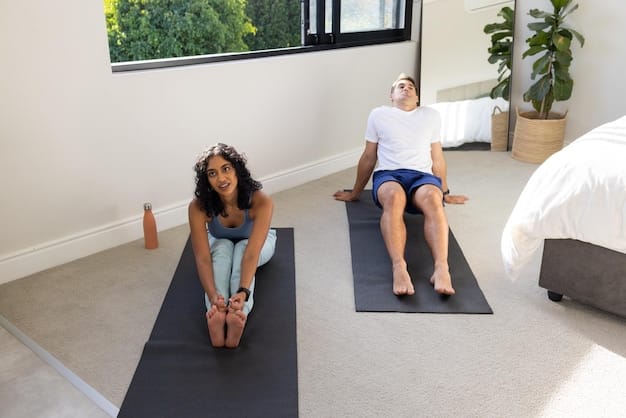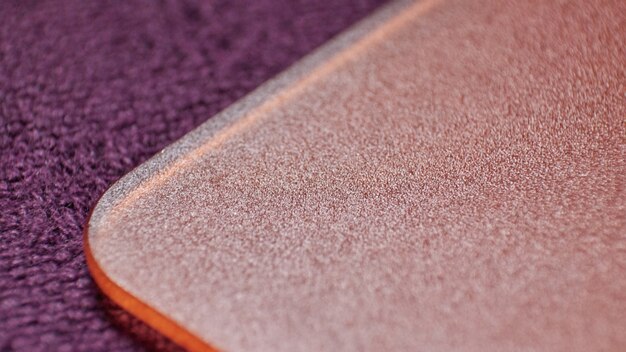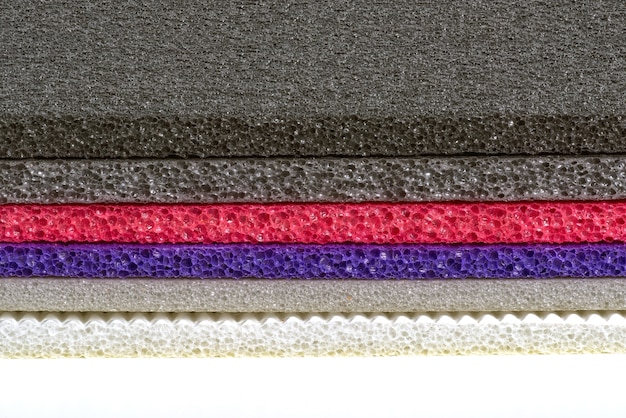Yoga Mat Materials: Choosing the Best for Your Practice and Budget

Choosing the right yoga mat material involves considering factors like grip, durability, environmental impact, and cost, with options ranging from natural rubber and jute to PVC and TPE, each offering distinct advantages and disadvantages depending on your practice style and budget.
Finding the perfect yoga mat can be a game-changer for your practice. But with so many materials on the market, how do you choose? This comparison: yoga mat materials – which is best for your practice and budget? will guide you through the options.
Understanding Yoga Mat Materials: An Overview
Yoga mats have come a long way, evolving from simple PVC rectangles to a diverse range of materials designed to enhance grip, support, and sustainability. Understanding the properties of these materials is crucial in making an informed choice.
Let’s explore the common types of yoga mat materials and what makes them unique.
Common Yoga Mat Materials
Several materials dominate the yoga mat market, each offering a different blend of performance and price.
- PVC (Polyvinyl Chloride): A synthetic plastic known for its affordability and durability.
- TPE (Thermoplastic Elastomer): A blend of plastic and rubber polymers offering a balance of cushioning and grip.
- Natural Rubber: A sustainable option prized for its excellent grip and eco-friendliness.
- Jute: A natural fiber that combines with rubber to create a textured, earthy mat.
- Cork: A naturally antimicrobial and sustainable material with a unique feel.
Each of these materials has its own set of pros and cons, which we’ll delve into in the following sections.

PVC Yoga Mats: Affordability and Durability
PVC yoga mats have been a long-standing staple of the yoga world, largely due to their budget-friendly price point and impressive durability. However, there’s more to consider than just cost when choosing a mat.
Let’s dive into the specifics of PVC mats and their potential impacts.
Pros and Cons of PVC Mats
PVC mats present a mixed bag of benefits and drawbacks.
- Pros: Highly durable, resistant to wear and tear, affordable, easy to clean.
- Cons: Not biodegradable, can contain phthalates (harmful chemicals), may have a strong odor initially, less eco-friendly.
The environmental concerns surrounding PVC have led many yogis to seek out alternative materials.
TPE Yoga Mats: The Balance of Comfort and Eco-Friendliness
TPE (Thermoplastic Elastomer) yoga mats offer a compelling middle ground, blending comfort and eco-consciousness. This material is gaining popularity as a more sustainable alternative to PVC.
Let’s examine what makes TPE mats stand out.
TPE Advantages
TPE mats come with several attractive benefits:
- Lightweight and portable.
- Offer good cushioning and support.
- Often recyclable.
- Free from PVC and latex.
While TPE mats are a step up in terms of environmental friendliness, they may not be as durable as PVC in the long run.

Natural Rubber Yoga Mats: Superior Grip and Sustainability
Natural rubber yoga mats are celebrated for their exceptional grip and eco-friendly qualities. Sourced from rubber trees, these mats offer a sustainable and high-performance option for dedicated yogis.
Discover why natural rubber is a top choice for many practitioners.
Key Features of Natural Rubber
Natural rubber mats boast several key characteristics:
- Excellent grip, even when wet.
- Biodegradable and sustainable.
- Provides a firm and supportive surface.
- May have a natural rubber odor initially.
If you’re seeking a mat that aligns with your values and enhances your practice, natural rubber is worth considering.
Jute Yoga Mats: Earthy Texture and Natural Appeal
Jute yoga mats offer a unique tactile experience, combining the natural fibers of jute with rubber for added grip and durability. These mats have a distinctive earthy aesthetic that appeals to eco-conscious yogis.
Explore the benefits of practicing on a jute mat.
Benefits of Jute Mats
Jute mats provide a distinct set of advantages:
- Natural and sustainable material.
- Textured surface provides good grip.
- Durable and long-lasting.
- Offers a grounding and earthy feel.
Jute mats are a great choice for those who appreciate natural materials and a tactile connection to the earth.
Cork Yoga Mats: Antimicrobial and Eco-Friendly Choice
Cork yoga mats are gaining traction for their naturally antimicrobial properties and sustainable sourcing. Made from the bark of cork oak trees, these mats offer a unique blend of hygiene and environmental responsibility.
Learn why cork is becoming a popular choice among yogis.
Advantages of Cork Mats
Cork mats stand out for their distinct advantages:
- Naturally antimicrobial and resistant to bacteria.
- Sustainable and renewable resource.
- Provides a firm and supportive surface.
- Offers a unique and comfortable feel.
For those prioritizing hygiene and sustainability, cork yoga mats are an excellent option.
| Key Feature | Brief Description |
|---|---|
| 🌱 Natural Rubber | Eco-friendly with excellent grip. |
| 💰 PVC | Affordable and durable, but less eco-friendly. |
| 🌿 Jute | Natural texture and good grip. |
| 🦠 Cork | Antimicrobial and sustainable. |
Frequently Asked Questions
▼
For beginners, a TPE or PVC mat is often recommended. They are affordable, provide adequate cushioning, and are easy to clean. As you progress, you can explore other materials.
▼
Most yoga mats can be cleaned with a mixture of water and mild soap. Avoid harsh chemicals, as they can damage the material. Always let the mat air dry completely before rolling it up.
▼
No, natural rubber mats are known for their excellent grip. In fact, they often provide better grip than synthetic materials like PVC, especially during sweaty practices.
▼
A standard yoga mat is about 3-5mm thick. If you need extra cushioning for your joints, consider a thicker mat (6mm or more). However, thicker mats can sometimes make balancing poses more challenging.
▼
For hot yoga, look for mats with good grip and moisture-wicking properties. Natural rubber and some TPE mats are popular choices, as they maintain their grip even when wet.
Conclusion
Ultimately, the best yoga mat material depends on your individual needs, priorities, and budget. By weighing the pros and cons of each option, you can make an informed decision and choose a mat that supports your practice for years to come.





